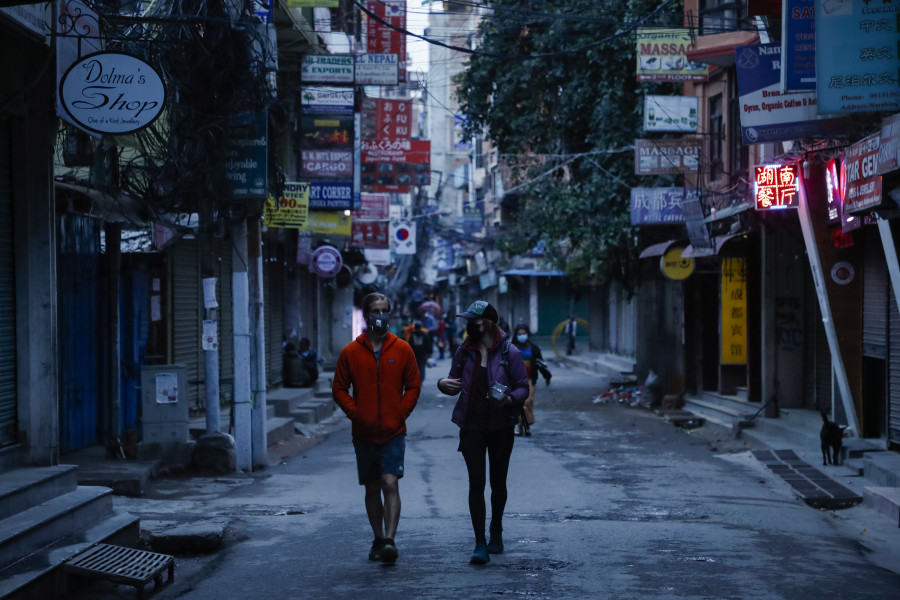Money
Asian Development Bank revises Nepal’s economic growth rate to 5.3 percent in light of Covid-19 pandemic
Economists, however, say this number is much too optimistic and forecast a more somber figure of around 4 percent.
Sangam Prasain
Nepal's economic growth is likely to see a sharp slowdown this fiscal year as the global Covid-19 pandemic cripples business and consumer spending, according to a report released Friday by the Asian Development Bank.
In the annual Asian Development Outlook 2020 report, the multilateral funding agency slashed its growth forecast for Nepal to 5.3 percent this fiscal year, which ends mid-July, a sharp decrease from last year's 7.1 percent growth.
Before the Covid-19 pandemic, the bank had forecast a 6.3 percent growth rate while the government had aimed for an ambitious target of 8.5 percent. While the bank has made necessary revisions taking the pandemic into account, the government has yet to revise its growth forecast.
Economists, however, say that the bank's revised growth rate is still “much too optimistic".
“Production, manufacturing, remittance, tourism—these key economic indicators have all suffered,” said economist Bishwamber Pyakurel. "That [5.3 percent growth] is just not possible. It's much too optimistic.”
Even before the pandemic, economists had warned that both the government’s estimate and the bank’s were too optimistic, saying that growth would hover at around 5 percent.
The nationwide lockdown, currently imposed from March 24 to April 7, and its subsequent effects on industry and services, combined with a potential fall in remittances, will undermine Nepal’s growth prospects, the bank said.
Lower agricultural output, in particular of paddy, which supplies nearly 7 percent to GDP will also dampen growth prospects. A late monsoon, flooding in some areas in early July, and pest infestation in others are the primary reasons behind the lower agricultural output.
The global Covid-19 outbreak has primarily affected services, constricting growth prospects, while industrial output is expected to slacken in response to reduced domestic demand. Industries, however, have also been closed ever since the lockdown was instituted.
Both supply and demand of industrial output, except essential goods and services, have substantially dropped. Major industries like cement, iron, steel, and bricks are operating below their full potential, the report said.
"Since mid-February, when the country's peak tourism season started and the harvest of winter crops particularly wheat and vegetables started, everything has been at a standstill," said economist Keshav Acharya. "Tens of thousands have been rendered jobless not only in the country, but in key labour destinations. Earnings have been largely affected."
Remittance has long been the lifeblood of Nepal’s economy, with the money sent back by nearly 500,000 migrant workers being equivalent to 28 percent of last year’s GDP.
Remittance income will be lower in the fourth quarter of this fiscal year due to Covid-19 and, subsequently, domestic spending, particularly on travel and recreation, are expected to plunge.
Given all these factors, Acharya too believes that the ADB's revised growth rate is still too optimistic.
"Even if the spread of Covid-19 is tamed, the growth will not be more than 4 percent this fiscal year," he said. "If the lockdown and the spread of the virus prolong, the consequences will be even worse."
For the past one-and-a-half months, the retail, restaurant and hotel sectors have all but shut down. The government has also cancelled the Visit Nepal 2020 campaign, which was expected to give a major boost to the economy, in the wake of Covid-19.
The report says that capital expenditure grew by 13.2 percent in the first six month of the current fiscal year, down from 14.7 percent a year earlier, while the execution of the annual capital budget fell to 15.2 percent from 17.2 percent.
Moreover, the limited disbursement of large allocations for national pride projects has only exacerbated the slowdown. The virus has also affected the implementation of ongoing projects, with the temporary lockdown further creating uncertainty with regard to project implementation.
“The impact of the coronavirus will be bigger than that of the trade embargo imposed by India in September 2015, which had lasted for three months,” said Pyakurel. "The government should quantify the impact of the coronavirus on the economy.”
The Asian Development Bank has also said that Nepal's inflation will climb to an average of 6 percent this fiscal year, up from 4.6 percent last fiscal year.
Food inflation increased by 10.2 percent in the first half of this fiscal with big increases in prices for vegetables, spices, and alcoholic beverages.
Food prices escalated due to the late monsoon,which depressed agricultural yields, and a ban on onion exports imposed by India, a major supplier.
The temporary closure of international borders over Covid-19 concerns has also nudged up food prices.
Prices of nonfood items such as clothing and footwear, furnishings and household equipment, healthcare and education services have also soared.
According to the bank, a 6.4 percent growth rate for Nepal has been envisaged for the upcoming 2020-2021 fiscal year, assuming a quick end to the Covid-19 pandemic, a rapid recovery, a normal monsoon and success in ongoing efforts to improve the business climate.
Two large infrastructure projects—the 456-megawatt Upper Tamakoshi Hydroelectric Project and the Gautam Buddha International Airport—will underpin investment, with both expected to begin operations by next fiscal year.
Most countries, including Nepal, are expected to suffer from the Covid-19 pandemic, which the Asian Development Bank has dubbed the "worst pandemic in a century", halting business operations, tourism, and household spending. Some economies could even enter a recession, the bank said. Growth in South Asia is forecast to decelerate from 5.1 percent in 2019 to 4.1 percent in 2020, but rebound to 6.0 percent in 2021.




 7.12°C Kathmandu
7.12°C Kathmandu













%20(1).jpg&w=300&height=200)
